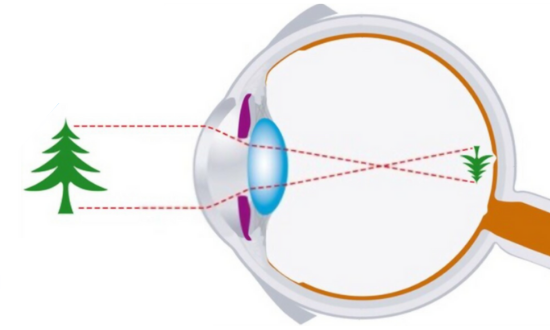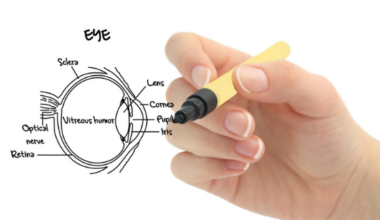How do we see objects with our eyes? Isn’t the thought itself interesting?
Let’s understand the mechanism of vision of the eye.
Your eyes are the windows that let you see things around you, absorb & admire the beauty around you, watch your loved ones and read your favorite books. Despite its small size, it is said to be the second most complex organ after the brain.
It is the most powerful sense organ such that about 80% of all our learning comes through the eyes. Hence, understanding the anatomy vision of the eye cannot be stressed enough.
In the front portion of the skull and below the forehead is a hollow formed by the formation of seven bones which is known as the Orbit. The eye is naturally fitted into this orbit. The liquid or the fat contains between the eye and the orbit makes the movement of the eye smooth and easy. On the back of the orbit lies a small hole through which optic nerves pass.
Right from early schooling days, we are taught about the 5 sense organs; eyes, ears, nose, tongue, and skin. Eyes help us see objects but how?
The mechanism of the vision of the human eye

The heat emitted by the energy of the Sun is the source of light for all human beings on the earth. Without the light of the Sun, we cannot survive on artificial lights for long.
These light rays touch various surfaces of the earth can reflect in various directions. Upon touching a transparent medium they refract and touching an opaque medium they reflect.

Our eyes are designed by nature to absorb these light rays to enable vision. The parallel light rays coming from their source enter our eyes. Starting from the very first layer, Cornea.
The cornea being convex in nature bends the light rays as it travels through its surface such that they converge. After converging to some extent they pierce through the pupillary gap inside the Iris. Depending upon the intensity of the light, your pupil naturally expands or contracts to control the amount of light entering inside the eye.
Now the light rays travel through the lens that is placed in between the anterior and the posterior portion of the eye.
The Crystalline Lens is biconvex by nature. Light rays when traveling through it bends furthermore converging to form a focal point. The point where all the light rays meet.
The light rays after getting bent through the lens travel the biggest portion of the eye Vitreous Humor which is forms the 80% of the eye to reach the Retina.
Your Retina is a film-like layer at the back of the eye where an image-focused through the lens is projected inverted on the retina, very much like the film of a camera.
The focal point is formed in the center of the retina. This is a very special part of the retina called the Macula. It is a structure in the retina specialized for most sharp vision. The periphery of the macula contains a high density of Rhodes wherein towards the center is Fovea that is highly populated with Cones. These are basically photoreceptors that fill colors in the images we see.
They convert the images formed into electrophysiological impulses that are transmitted to the brain via optic nerves. Each eye sends one image via the optic nerve to the brain which is also known as Binocular Vision. This is because the same object is viewed by each eye at two different angles resulting in two slightly different images of the same object. The brain then compares and merges these two images to gain an understanding of the distance of the object. The brain’s ability to sense distance is called Depth Perception. The area of the brain that receives and interprets the images is known as the Visual Cortex.
Along with the mechanism of the vision, understanding some important terminologies surrounding vision is also important. These three terminologies define the quality of vision:
- Visual Field (VF)
The term used to define the breadth of our peripheral vision is the visual field (VF). Typically, our VF is 180 degrees or half a circle. We ought to be able to feel motion from our right or left shoulder while looking straight.\
It is possible to measure the visual field in a different manner. VF is usually calculated using Visual Field Analyzer or by a manual examination called the Goldmann VF exam.
Vision fields can be checked in one eye at a time (Monocular) or use both eyes at a time (Binocular). The VF of a human is determined by telling them to fixate their eyes straight ahead. Then, from the side, a light source is moved into their field of view. Once they see the light, the patient then presses a button. Tunnel vision and blind spots are determined by the results of the VF test.
- Visual Acuity (VA)
The clarity of the image seen by the eye is known as visual acuity (VA). VA is measured at a distance of 20 feet or six meters using an eye test chart.
20/20 VA is normal vision. It is called 6/6 VA in metric units since 20 feet is equivalent to six meters. A VA of 20/20 means that a natural sighted person can see line 20 distinctly while standing 20 feet away from the Snellen chart commonly known as the eye chart. The history of the Snellen eye chart goes back to 1862.
An individual with a weak VA will need refractive correction glasses or contact lenses to correct their vision to 20/20.
- Legally Blind
There are several different definitions of the word ‘legally blind’. It is best recommended that you ask your optometrist or ophthalmologist or optician what your province, state or country’s normal definition of “legally blind” is.
There are other areas of vision skills that lead to overall visual efficiency. They include:
- Peripheral vision
- Coordination of the Eye
- Perception of Depth
- Focus capacity
- Color vision
A condition with any part of the eye may cause issues with vision. There are several types of eye disorders that can in multiple ways influence vision.
Summary
We may say that eye is only a transmitter; it is our brain that sees the world. This action is performed in the brain so fast and so continuously that it is hard to comprehend.
Imagine yourself when is it that we are not looking around even during our normal routine? Everything you are seeing is the result of this simple yet complex mechanism of the eye and the brain.
Despite all that we gain through our eyes, little do we do to protect them from the Sun damage. The global warming effect caused by the porosity of the Ozone layer stressed the importance of protection from UV especially in countries that are most impacted by UV.
Wearing good quality UV protective lenses and sunglasses while out or about is important to prevent UV damage. There is a wide variety of buying options in the market, you can research a little online or consult your optician.
Your eyes are precious; donate them so that someone can see the world through your eyes after you!



